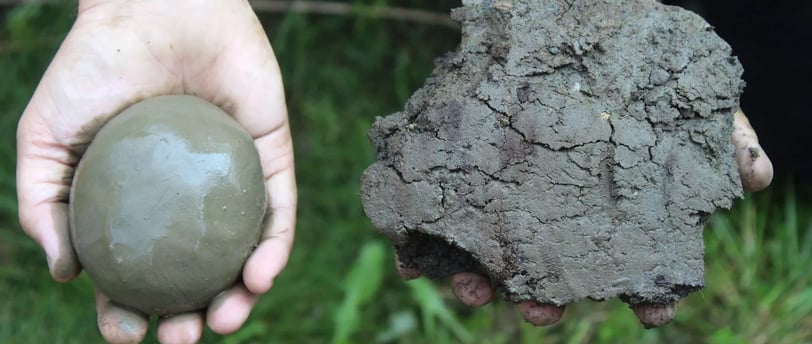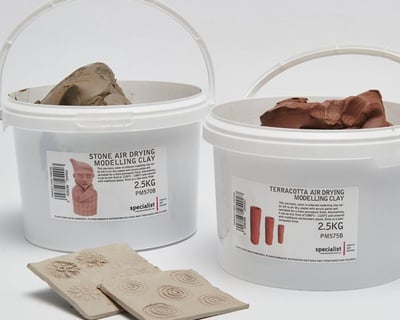Natural Clay vs Air Dry Clay
A Question of Sustainability
10/20/20245 min read


As someone who adores the earthy, grounding feel of natural clay, the experience of working with it is deeply personal and tactile. The way it slips through your fingers, its rawness, and the ancient connection it brings to nature makes it an emotionally rich material. However, in today's world, when sustainability and environmental impact are central to many of our decisions, it's worth asking: Which is better for the environment—natural clay or air-dry clay?
The Emotional Connection to Natural Clay
For me, there’s something undeniably spiritual about natural clay. It's sourced straight from the earth, and molding it brings a sense of closeness to nature itself. Whether I’m sculpting or making pottery, the process feels both grounding and timeless. It's as though each creation is part of an age-old tradition, connecting me to human artisans of the past.
But when I started to reflect on the environmental impact of this beloved material, I realized it was important to think beyond the sensory joy it brings. Even though working with natural clay feels "right," it’s necessary to ask how it affects our planet, especially when the process includes firing in a kiln, which consumes significant energy.
The Sustainability of Natural Clay
Natural clay, being just that—**natural**—is abundant and non-toxic, and it’s a fully recyclable material as long as it remains unfired. Leftover or unused clay can be reclaimed, rehydrated, and worked back into new projects, reducing waste. However, the real issue comes when you consider the kiln-firing process.
Firing natural clay requires high temperatures, often upwards of 1,000°C, which typically comes from gas or electricity. This process is energy-intensive, with large kilns consuming substantial amounts of power. Depending on how the electricity is generated (from renewable sources or fossil fuels), this can lead to a significant carbon footprint. Moreover, the mining and transportation of clay, especially when not sourced locally, adds to its environmental impact.
Despite these downsides, the longevity of fired clay makes it a sustainable option for certain uses. Fired pieces can last centuries and even millennia—think of ancient pottery still being unearthed today! This durability means that objects made from natural clay can have a very long life cycle, reducing the need for replacements and thus lessening waste over time.
Air-Dry Clay: The Sustainable Alternative?
Air-dry clay, on the other hand, offers an alternative that doesn't require a kiln for hardening. This alone cuts down a huge portion of the energy consumption associated with traditional ceramics. Air-dry clay hardens naturally when exposed to air, making it much more accessible for home crafters or artists who don’t have access to a kiln.
However, not all air-dry clays are created equal. Many varieties on the market are polymer-based, which means they’re essentially a type of plastic.


These synthetic air-dry clays are derived from petrochemicals, making them non biodegradable. Over time, they contribute to plastic waste, lingering in the environment for hundreds of years. While the absence of firing reduces energy use, the long-term impact of these materials is more problematic.
There are natural, biodegradable air-dry clays available, which are often made from materials like paper pulp or other plant fibers. These clays offer a more eco-friendly solution, as they can decompose naturally over time. If your goal is sustainability, seeking out these natural options is key to avoiding the pitfalls of synthetic materials.
Energy Use in Producing Air-Dry Clay vs. Natural Clay
One often overlooked aspect is the energy used to produce a bag of air-dry clay versus natural clay. While air-dry clay skips the energy-intensive kiln-firing process, its production—especially in the case of synthetic clays—can still be energy-hungry.
Synthetic air-dry clays are derived from petrochemicals, meaning their production requires energy at multiple stages: extracting raw materials like oil, refining these materials into plastics, and processing them into a usable clay-like texture. This manufacturing process, from petrochemical extraction to molding, can be highly energy-intensive, even though the end product doesn’t require firing.
By contrast, natural clay requires less industrial processing before it’s ready to be used. It's typically mined, cleaned, and packed, meaning the energy consumption is mostly in the initial mining and transportation. So, while natural clay does require energy for firing, the energy involved in getting it to a workable state is significantly lower than that of synthetic air-dry clays.
If you're looking for the most sustainable option, natural air-dry clays, made from biodegradable materials like plant fibers, have a smaller energy footprint. These clays avoid both kiln-firing and the petrochemical processes, offering a lower-energy alternative that’s better for the planet overall.


Comparing Their Environmental Impact
1. Energy Use:
Natural clay requires kiln-firing, which uses significant energy.
Air-dry clay (especially natural, biodegradable varieties) skips this step entirely, reducing energy consumption.
However, synthetic air-dry clays use more energy during production due to the petrochemical processes involved.
2. Material Composition:
Natural clay is abundant and free from harmful chemicals but involves mining and transportation impacts.
Some air-dry clays are polymer-based and can contribute to long-term plastic pollution, while natural options are biodegradable.
3. Longevity and Lifecycle:
Fired natural clay lasts for centuries, making it durable and sustainable over long periods.
Air-dry clay is generally less durable but may still be sufficient for decorative pieces that don’t need to withstand wear and tear.


Which Is the Better Choice?
If you, like me, feel a spiritual connection to natural clay, its timelessness and durability make it a sustainable option in certain contexts, especially when sourced locally and fired using efficient kilns and firing methods. However, if energy consumption is a concern and your projects are smaller or less functional, biodegradable air-dry clay can offer a more environmentally friendly alternative. This will be on my for my wish list as I have never created with biodegradable air dry clay. Look out for the results of that clay experimentation. can it match natural clay?
Ultimately, it comes down to your values as a creator. If you prioritise minimising energy use, natural air-dry clay is a great alternative. But if you value the long-term durability and heritage of your creations, natural clay—with mindful choices about firing—can still be a deeply rewarding and sustainable choice.
Whichever material you choose, understanding their environmental impacts allows us to craft with intention and care, honouring both the creative process and the planet. So lets explore eco-friendly options, think about the energy footprint of your materials, and choose what resonates with both your artistic vision and environmental values.
Nature, Artistry, Sustainability
Transforming nature into beautiful, functional creations.
Harvesting Connections
ayeshaweekes@gmail.com
07958487488
© 2024. All rights reserved.
